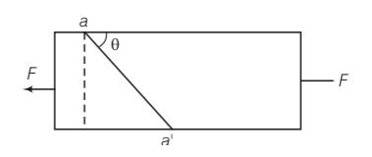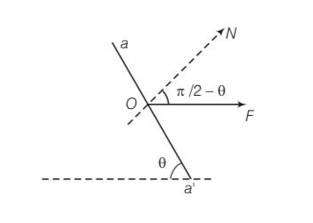Consider a long steel bar under a tensile stress due to forces F acting at the edges along the length of the bar (Fig. 9.5). Consider a plane making an angle θ with the length. What are the tensile and shearing stresses on this plane?
(a) For what angle is the tensile stress a maximum?
(b) For what angle is the shearing stress a maximum?

Consider a long steel bar under a tensile stress due to forces F acting at the edges along the length of the bar (Fig. 9.5). Consider a plane making an angle θ with the length. What are the tensile and shearing stresses on this plane?
(a) For what angle is the tensile stress a maximum?
(b) For what angle is the shearing stress a maximum?

-
1 Answer
-
This is a long answer type question as classified in NCERT Exemplar
Let the cross sectional area A . consider the equilibrium of the plane aa’. A force F must be acting on this plane making an angle of with the normal ON. Resolving F into components along the plane (FP) and normal to the plane.
By resolving into components

We get Fp= Fcos
And FN= Fsin
Let area of the face aa’ be A’ then
A/A’=sin so A=A’sin
The tensile stress = normal force/area=Fsin
= sin2
Shearing stress = parallel foce/Area
=
a) For stress to be maximum , sin2 =1
So =
b) Shearing stress to be maximum
sin2
So =
Similar Questions for you
If is Poisson’s ratio,
Y = 3K (1 - 2 ) ……… (1)
and Y = 2 ……… (2)
With the help of equations (1) and (2), we can write
dm = (m/L)dx
∴ T = (mω²/2L) (L² - x²)
∴ ΔL = ∫? (mω²/2Lπr²Y) (L² - x²)dx
= ΔL = mω²L²/3πr²Y
Initially S? L = 2m
S? L = √2² + (3/2)²
S? L = 5/2 = 2.5 m
? x = S? L - S? L = 0.5 m
So since λ = 1 m. ∴? x = λ/2
So white listener moves away from S? Then? x (= S? L − S? L) increases and hence, at? x = λ first maxima will appear.? x = λ = S? L − S? L.
1 = d - 2 ⇒ d = 3 m.
Loss in elastic potential energy = Gain in KE
½ (YA/L)x² = ½mv²
0.5 × (0.5×10? × 10? / 0.1) × (0.04)² = 20×10? ³ v²
0.5 × (5×10²) × 1.6×10? ³ = 20×10? ³ v²
0.4 = 20×10? ³ v²
v² = 20 => v = √20 ≈ 4.47 m/s
(Re-checking calculations)
0.5 * ( (0.5e9 * 1e-6) / 0.1) * (0.04)^2 = 0.5 * (5e2) * 1.6e-3 = 4.
0.5 * 20e-3 * v^2 = 10e-3 v^2
4 = 10e-3 v^2
v^2 = 400 => v = 20 m/s
As we know that
If length and diameter both are doubled
Taking an Exam? Selecting a College?
Get authentic answers from experts, students and alumni that you won't find anywhere else
Sign Up on ShikshaOn Shiksha, get access to
- 65k Colleges
- 1.2k Exams
- 679k Reviews
- 1800k Answers
